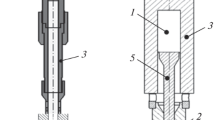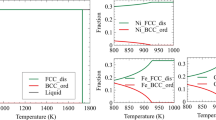Abstract
We propose to regard investigations in the field of high-temperature strength of structural metals and alloys interacting with corrosive media as high-temperature physicochemical mechanics of materials (HTPCMM). The most important feature of HTPCMM is the principle of correlation between deformation processes and physicochemical phenomena, which allows one to describe the features and regularities of changes in the properties of materials under service conditions most completely and correctly. We emphasize the most important role of diffusion as a controlling factor in a metal–medium system at high temperatures. Results of analytical investigations aimed at the development and investigation of physicomathematical models of elastic and elastoviscous multicomponent solid solutions with inherent degradation processes (accumulation of damage) are presented. The fact that, as a rule, these models are constructed within the framework of continuum mechanics on the basis of principles of nonequilibrium mechanics is noted Experimental data obtained, in particular, on refractory metals and titanium interacting actively with components of a vacuum or an inert atmosphere testify to the intensification of saturation of metals by interstitial impurities under conditions of long-term loading and to significant changes in the character of their creep, namely, under the influence of oxygen diffusion the creep rate decreases as stresses increase.
Similar content being viewed by others
REFERENCES
S. Taira and R. Ohtani, A Theory of High-Temperature Strength of Materials [Russian translation], Metallurgiya, Moscow (1986).
Ya. S. Podstrigach, “A diffusion theory of deformation of an isotropic continuum,” Vopr. Mekh. Real. Tverd. Tela, No. 2, 71–99 (1964).
Ya. S. Podstrigach, “A diffusion theory of inelasticity of materials,” Prikl. Mekh. Tekhn. Fiz., No. 2, 67–72 (1965).
Ya. S. Podstrigach and V. S. Pavlina “Influence of the diffusion process on the stress concentration near a circular hole,” in: Stress Concentration [in Russian], Issue 1, Naukova Dumka, Kiev (1965), pp. 29–31.
V. S. Pavlina and Ya. S. Podstrigach, “Residual stresses caused by diffusion in an elastic homogeneous plate,” Fiz.-Khim. Mekh. Mater., 4, No. 4, 384–389 (1968).
Ya. S. Podstrigach and V. S. Pavlina “Differential equations of thermodynamic processes in an n-component solid solution,” Fiz.-Khim. Mekh. Mater., 1, No. 4, 383–389 (1965).
V. S. Pavlina “Kinetic equations of elastoplastic deformation of solid bodies in the presence of physicochemical processes,” Dopov. Akad. Nauk Ukr. RSR, Ser. A, No. 5, 437–441 (1978).
Ya. S. Matychak, V. S. Pavlyna, and V. M. Fedirko, “Diffusion processes and mechanics of materials,” Fiz.-Khim. Mekh. Mater., 34, No. 3, 13–23 (1998).
V. S. Pavlina, V. M. Fedirko, Ya. S. Matychak, and T. S. Tarlupa, “Analysis of kinetics of sublimation of alloying elements of alloys with regard for chemical transformations,” Fiz.-Khim. Mekh. Mater., 21, No. 6, 60–64 (1985).
V. S. Pavlina, O. Ya. Lizun, and Ya. S. Matychak, “Residual tensile stresses in undersurface layers of cylindrical specimens after diffusion saturation,” Fiz.-Khim. Mekh. Mater., 23, No. 1, 85–89 (1987).
A. F. Olemskoi and I. A. Sklyar, “Evolution of defective structure of a solid body in the course of plastic deformation,” Usp. Fiz. Nauk, 162, No. 6, 29–79 (1982).
J. Grabacki, “Mechanika materiałów ze structurą wewnĉtrzną,” P. Krak., No. 131, 1–48 (1992).
Yu. N. Robotnov, Creep of Structural Members [in Russian], Nauka, Moscow (1966).
L. M. Kachanov, Fundamentals of Fracture Mechanics [in Russian], Nauka, Moscow (1974).
I. M. Perets and A. I. Shchur, “Mathematical models of damage accumulation under long-term high-temperature creep,” Tochn.Nadezhn. Mat. Sistem, No. 14, 92–98 (1988).
K. S. Ghan, “The constitutive representation of high-temperature creep damage,” Int. J. Plast., 4, No. 4, 355–370 (1988).
I. G. Ovchinnikov and Yu. M. Pochtman, “Analysis and rational design of structures subjected to corrosion wear (survey),” Fiz.-Khim. Mekh. Mater., 27, No. 2, 7–19 (1991).
Li Changeun, Li Xiping, and Li Guagxia, “A fracture damage evolution law for a cylindrical specimen irradiated by laser beam,” Eng. Fract. Mech., 36, No. 1, 9–15 (1990).
Wang June, “A continuum damage mechanics model for low-cycle fatigue failure of metals,” Eng. Fract. Mech., 41, No. 3, 437–441 (1992).
S. V. Marushin, “Evaluation of the resistance to thermal fatigue with regard for damageability,” in: Works of TsKTI [in Russian] (1988), pp. 119–126.
V. V. Bolotin and A. A. Shipkov, “Mechanical aspects of corrosion fatigue and stress corrosion cracking,” Int. J. Solid Struct., No. 38, 7297–7318 (2001).
N. Petrov and I. Brankov, Contemporary Problems in Thermodynamics [Russian translation], Mir, Moscow (1986).
J. Kratochvil and A. W. Dillon, “Thermodynamics of crystalline elastic-viscoplastic materials,” J. Appl. Phys., 41, No. 4, 54–72 (1970).
V. N. Aptukov, “A continuum model of anisotropic damage” in: Deformation and Fracture of Structurally Inhomogeneous Materials [in Russian], Sverdlovsk (1992), pp. 41–52.
V. Zheng, Z. J. Luo, and X. Zheng, “New model of damage of plastic materials,” Eng. Fract. Mech., 41, No. 1, 103–110 (1992).
V. S. Pavlina, “Kinetic equations of elastoplastic deformation of solid bodies in the presence of physicochemical phenomena,” Dopov. Akad. Nauk Ukr. RSR, Ser. A, No. 5, 438–441 (1978).
I. Weitsman, “Stress assisted diffusion in elastic and viscoelastic materials,” J. Mech. Phys. Solids, 35, No. 1, 73–93 (1987).
Ya. I. Burak and E. Ya. Chaplya, “Continuum models of nonlinear thermomechanics of binary systems,” Fiz.-Khim. Mekh. Mater., 31, No. 4, 7–15 (1995).
V. S. Pavlyna, “Mathematical modelling of interdependent physicochemical processes and degradation under loading of elastoviscous materials,” Fiz.-Khim. Mekh. Mater., 35, No. 2, 7–11 (1999).
V. S. Pavlyna, O. H. Luk'yanenko, A. T. Pichuhin, and V. M. Fedirko, “Formation of functional layers on titanium alloys under nonstationary conditions,” Fiz.-Khim. Mekh. Mater., 36, No. 2, 65–75 (2000).
G. S. Pisarenko, V. A. Borysenko, S. S. Gordetskii, et al., Strength of Refractory Metals [in Russian], Metallurgiya, Moscow (1970).
N. P. Drozd, High-Temperature Long-Term Strength of Niobium and Molybdenum, Depending on the Structural State and Purity of Protecting Atmosphere (Vacuum and Argon) [in Russian], Author's Abstract of the Candidate-Degree Thesis (Technical Sciences), Lviv (1975).
I. S. Tsvilyuk, I. O. Marusii, and E. N. Kaspruk, “Regularities of changes in the long-term strength characteristics of niobium alloys in vacuum of different levels,” Fiz.-Khim. Mekh. Mater., 14, No. 6, 19–21 (1978).
T. K. Roche, “Influence of vacuum on the creep of the Nb0.6Zr alloy at a temperature of 1000°C,” in: Refractory Metals in New Engineering. Proceedings of the 3d Technical Conference on Refractory Materials (Los Angeles, December 1963) [Russian translation], Mir, Moscow (1969), pp. 189–202.
O. I. Eliseeva, “Specific features of high-temperature deformation and structural state of SB-1 alloy under conditions of creep in a rarefied oxygen flow,” Fiz.-Khim. Mekh. Mater., 19, No. 6, 22–27 (1983).
H. Maksymovich, V. Pavlyna, and V. Shyrokov, “Prediction of long-term strength of refractory metals in corrosive medium,” in: Works of NTSh [in Ukrainian], Vol. 3 (1998), pp. 30–35.
V. V. Shirokov and O. I. Eliseeva, “Influence of impurity atoms on the mechanical properties of metals of V-A group and their alloys,” Fiz.-Khim. Mekh. Mater., 18, No. 6, 16–20 (1982).
N. Birks and G. H. Meier, Introduction to High-Temperature Oxidation of Metals [Russian translation], Metallurgiya, Moscow (1987).
A. Takei and K. Nii, “Influence of tensile stress on the high-temperature oxidation of nickel-chromium-aluminum alloys,” Nihon Kinzoku Gakkaishi, 44, No. 6, 603–608 (1980).
E. Osida, A Method for Hardening an Internally Oxidable Metallic Material, Japanese Patent; No. 603352.
G. Martin, “Transformations de phase et plasticité,” Ann. Chim. France, 6, No. 3, 46–58 (1981).
I. S. Tsvilyuk, V. A. Pyl'nikov, and V. A. Men'shikh, “Influence of interstitial impurities on the mechanical properties of niobium and its alloys,” Probl. Prochn., No. 2, 45–50 (1976).
G. G. Maksimovich, E. M. Lyutyi, V. F. Shatinskii, et al., High-Temperature Serviceability of Refractory Metals and Alloys in Corrosive Media [in Russian], Naukova Dumka, Kiev (1982).
O. I. Eliseeva, Structural Transformations in Vanadium and Niobium Alloys in the Course of Saturation by Nitrogen and the Development of a Method for Their Hardening [in Russian], Author's Abstract of the Candidate-Degree Thesis (Technical Sciences), Lviv (1984).
V. M. Fedirko, “High-temperature physicochemical interaction of titanium and its alloys with a gaseous atmosphere,” Fiz.-Khim. Mekh. Mater., 26, No. 2, 48–53 (1990).
G. G. Maksimovich, V. M. Fedirko, Ya. I. Spektor, and A. T. Pichugin, Thermal Treatment of Titanium and Aluminum Alloys in Vacuum and Inert Media [in Russian], Naukova Dumka, Kiev (1987).
V. M. Fedirko, A. T. Pichuhin, and O. H. Luk'yanenko, “Influence of deformation texture on the high-temperature interaction of titanium with rarefied gases,” Fiz.-Khim. Mekh. Mater., 32, No. 5, 28–36 (1996).
I. M. Pohrelyuk, “Nitriding of titanium under nonisothermal conditions,” Fiz.-Khim. Mekh. Mater., 34, No. 2, 75–78 (1998).
O. H. Luk'yanenko, V. S. Pavlyna, A. T. Pichuhin, and V. M. Fedirko, “Influence of thermal cycling on the high-temperature interaction of titanium with gases,” Fiz.-Khim. Mekh. Mater., 33, No. 6, 7–14 (1997).
V. S. Pavlyna, O. H. Luk'yanenko, A. T. Pichuhin, and V. M. Fedirko, “Formation of functional layers on titanium alloys under nonstationary conditions,” Fiz.-Khim. Mekh. Mater., 36, No. 2, 65–75 (2000).
Author information
Authors and Affiliations
Rights and permissions
About this article
Cite this article
Maksymovych, H.H., Fedirko, V.M. & Pavlyna, V.S. High-Temperature Physicochemical Mechanics of Materials. Materials Science 38, 161–171 (2002). https://doi.org/10.1023/A:1020971901172
Issue Date:
DOI: https://doi.org/10.1023/A:1020971901172




